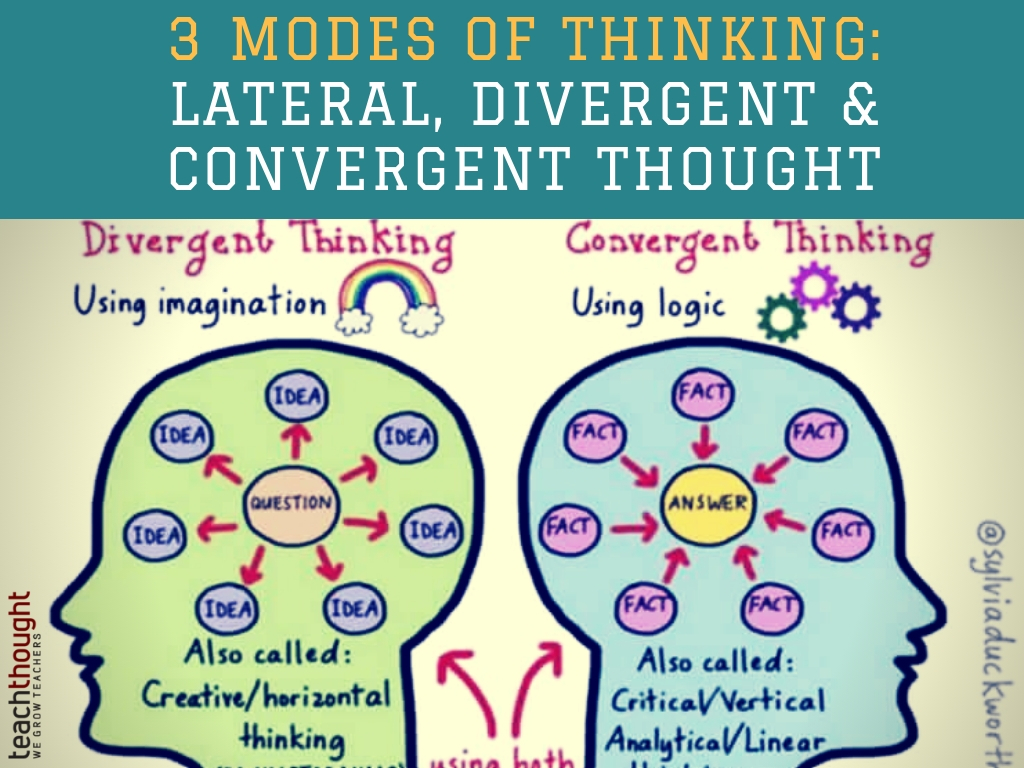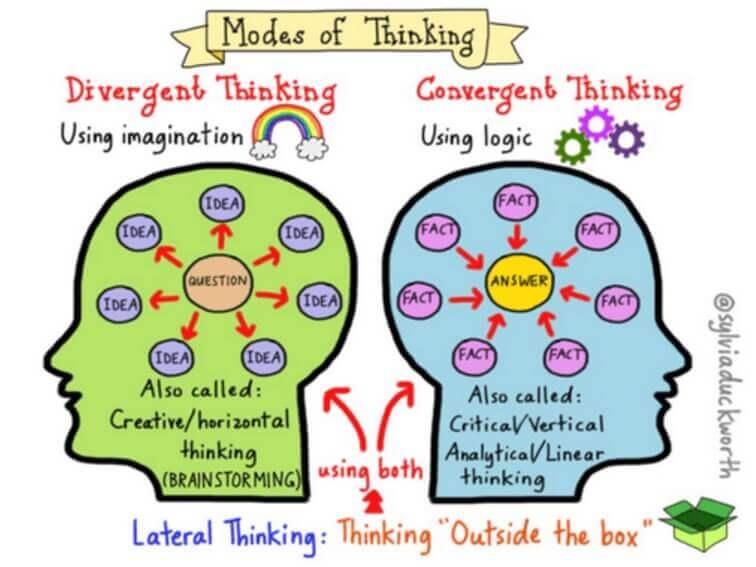
3 Modes Of Thinking: Lateral, Divergent & Convergent Thought
by TeachThought Staff
TeachThought is about, more than anything else, human improvement.
A core tenet of humanity is our ability to think critically and with imagination and creativity. Therefore, it makes sense that our ability–and the decision to–do this consistently in some ways defines us as a species. Critical thinking, in part, involves simply avoiding cognitive biases.
See also What It Means To Think Critically
Further, it’s not a huge leap to say that the ability and tendency to think critically and carefully and creatively supersedes content knowledge in importance, but that’s a discussion for another day. In general, it is our position that critical thinking is of huge importance for students, and as such is a big part of our content and mission at TeachThought.

In pursuit, the sketch note above from Sylvia Duckworth is a nice addition to that index of content. Sylvia has consistently done a great job converting ideas into simple visuals–on our 12 Rules Of Great Teaching, for example.
You can follow Sylvia on twitter here.
We’ve taken the visual and fleshed it out with some commentary from Wikipedia (a resource we love, by the way).
3 Modes Of Thinking: Lateral, Divergent & Convergent Thought
1. Convergent Thinking
Summary: Using logic
Also called: Critical Thinking, Vertical Thinking, Analytical Thinking, Linear Thinking
Wikipedia Excerpt & Overview
‘Convergent thinking is a term coined by Joy Paul Guilford’ (who also coined the term for the ‘opposite’ way of thinking, ‘Divergent Thinking’).
‘It generally means the ability to give the “correct” answer to standard questions that do not require significant creativity, for instance in most tasks in school and on standardized multiple-choice tests for intelligence.
Convergent thinking is often used in conjunction with divergent thinking. Convergent thinking is the type of thinking that focuses on coming up with the single, well-established answer to a problem.[1] Convergent thinking is used as a tool in creative problem-solving. When an individual is using critical thinking to solve a problem they consciously use standards or probabilities to make judgments.[2] This contrasts with divergent thinking where judgment is deferred while looking for and accepting many possible solutions.’
2. Divergent Thinking
Summary: Using imagination
Also called: Creative Thinking or Horizontal Thinking
Wikipedia Excerpt & Overview
‘Divergent thinking is a thought process or method used to generate creative ideas by exploring many possible solutions. It is often used in conjunction with its cognitive colleague, convergent thinking, which follows a particular set of logical steps to arrive at one solution, which in some cases is a ‘correct’ solution. By contrast, divergent thinking typically occurs in a spontaneous, free-flowing, ‘
By contrast, divergent thinking typically occurs in a spontaneous, free-flowing, ‘non-linear’ manner, such that many ideas are generated in an emergent cognitive fashion. Many possible solutions are explored in a short amount of time, and unexpected connections are drawn. After the process of divergent thinking has been completed, ideas and information are organized and structured using convergent thinking.’
3. Lateral Thinking
Summary: Using both Convergent and Divergent Thinking
Also called: ‘Thinking Outside the Box’
Wikipedia Excerpt & Overview
‘Lateral thinking is solving problems through an indirect and creative approach, using reasoning that is not immediately obvious and involving ideas that may not be obtainable by using only traditional step-by-step logic.[1]
To understand lateral thinking, it is necessary to compare lateral thinking and critical thinking. Critical thinking is primarily concerned with judging the truth value of statements and seeking errors. Lateral thinking is more concerned with the “movement value” of statements and ideas. A person uses lateral thinking to move from one known idea to creating new ideas.’
3 Modes Of Thinking: Lateral, Divergent & Convergent Thought
